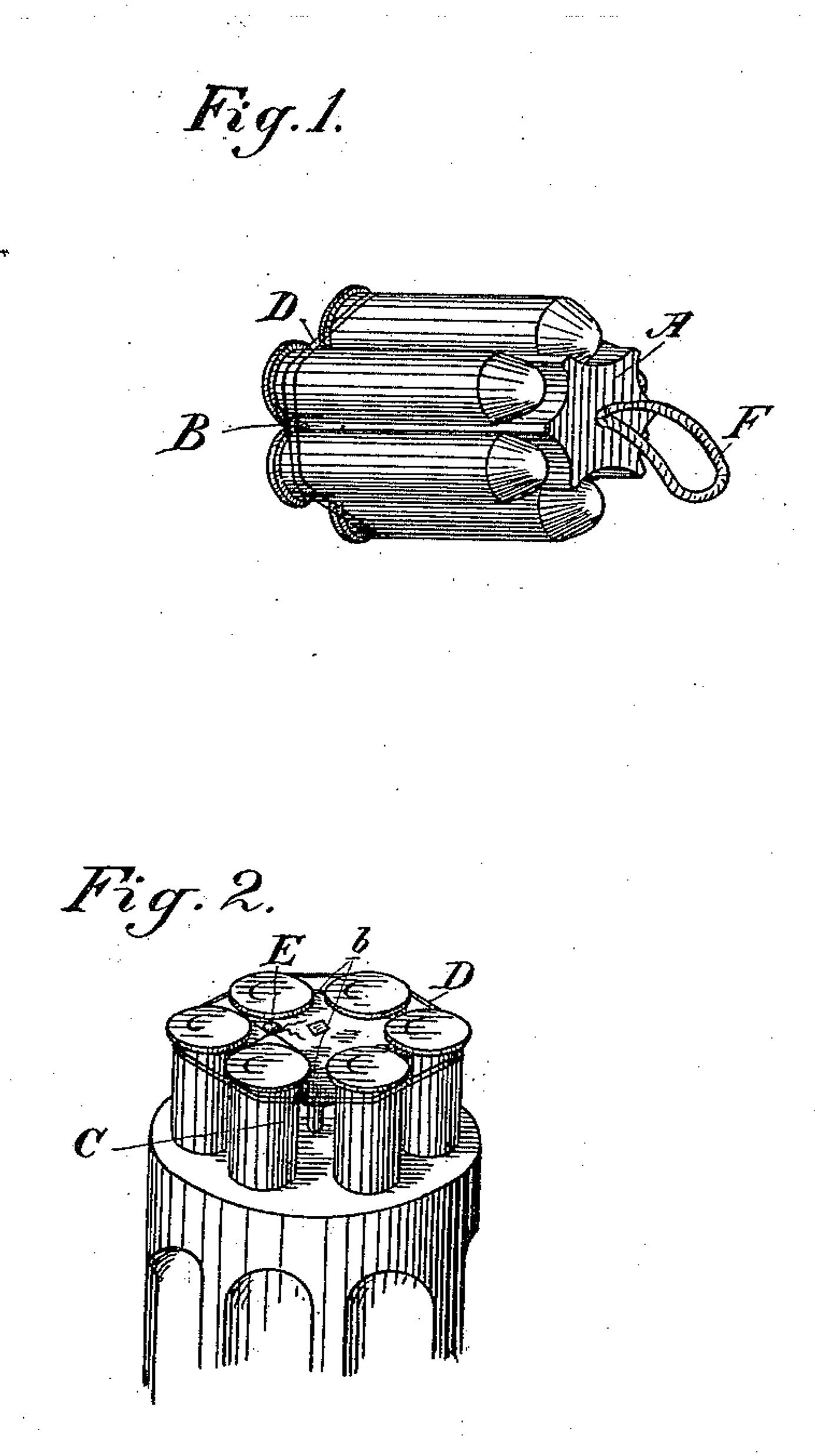US 331891
UNITED STATES PATENT OFFICE.
JOHN C. KELTON, OF SAN FRANCISCO, CALIFORNIA.
CARTRIDGE-PACK.
SPECIFICATION forming part of Letters Patent No. 331,891, dated December 8, 1885.
Application filed October 1, 1885. Serial No. 178,766. (No model.)
To all whom it may concern:
Be it known that I, JOHN C. KELTON, of the city and county of San Francisco, State of California, have invented an Improvement in Pistol-Cartridge Packs; and I hereby declare the following to be a full, clear, and exact description of the same.
My invention relates to a means for rapidly reloading the chambers of revolvers; and it consists of cartridges secured together so as to be in line with the chambers of the revolver, into which they can all be instantly inserted and the holding device removed.
Referring to the accompanying drawings for a more complete explanation of my invention, Figure 1 is a view showing the cartridges packed together ready for use. Fig. 2 shows them partially inserted into the chambers of the revolver.
This pack affords a means by which the chambers of the Smith & Wesson and similarly-constructed pistols can be loaded simultaneously.
A and B are two parts of a spindle, which is grooved or chambered, so that the cartridges may be assembled around it at such distances that they will stand exactly in line with the chambers of the revolver when placed opposite to them.
In the upper or rear end of the shouldered portion B of the spindle is fixed a pin, E, to which one end of a small wire, D, is fastened. The wire is then passed two or three times around the cartridges, and the opposite end is twisted around this pin, thus holding them in place. These cartridges are put up in packages of this description at the armory or other convenient place, and may be surrounded by an envelope of paper or otherwise packed for transportation and protection until ready for use. The inclosing-case is readily drawn off or removed when the pistol is to be charged. The lower part, A, of the spindle is drawn away by means of a loop, F, which is attached to it. The ends of the cartridges are then inserted into the cylinder-chambers, being still held in position upon the shouldered portion of the spindle by the wire which is around them. When the central pin, C, of the spindle strikes the end of the cylinder, the wire is unwound, and the top part, B, of the spindle (which has beveled edges b) is drawn away, leaving the cartridges to fall into the chambers, after which the pistol may be closed. By this means the six chambers of the revolver may be loaded in four seconds. The need of such a pack for certain and rapid reloading is absolutely necessary in war, and especially where the pistol is used in hand-to-hand combat, where success depends upon the rapidity with which the pistol can be reloaded and discharged.
Having thus described my invention, what I claim as new, and desire to secure by Letters Patent, is—
1. A central spindle composed of two parts, a wire or tape having one end secured to a pin in the upper and shorter portion, said wire being wound or twisted around the exterior of the cartridges and secured to the pin, substantially as herein described.
2. A cartridge-pack consisting of a two-part spindle having exterior grooves or channels, within which the cartridges are held by a tape or wire passing around their exterior, with the ends properly secured, in combination with a loop, by which the outer portion of the spindle may be removed to allow the cartridges to be introduced into the pistol, substantially as herein described.
In witness whereof I have hereunto set my hand.
JOHN C. KELTON.
Witnesses:
ALFRED PANSHO,
JOHN G. KELLY.

